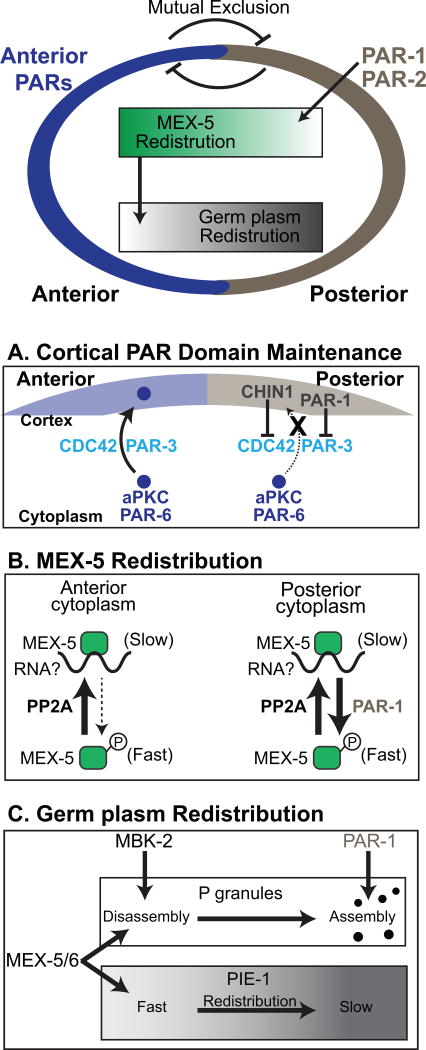Figure 2.
Establishment of the Anterior/Posterior axis in the C. elegans zygote. In the polarized C. elegans zygote, the Anterior PARs (Blue) are enriched at the anterior cortex and PAR-1 and PAR-2 (brown) are enriched at the posterior cortex. Antagonistic interactions between the PAR proteins mediates their mutual exclusion. PAR-1 directs the redistribution of MEX-5 to the anterior cytoplasm and MEX-5 contributes to the redistribution of germ plasm proteins to the posterior cytoplasm. All of these factors are symmetrically distributed before symmetry breaking. A. Asymmetric PAR domains are maintained in part by the recruitment of cytoplasmic PAR-6 and aPKC to the anterior, but not to the posterior, cortex. PAR-1 and CHIN-1 restrict PAR-3 and active CDC42 from the posterior cortex, thereby preventing the recruitment of PAR-6 and aPKC from the cytoplasm to the posterior cortex. Other mechanisms that contribute to PAR domain maintenance are described in the text and not illustrated for simplicity. B. The redistribution of MEX-5 to the anterior cytoplasm is controlled by PAR-1. PAR-1 phosphorylates MEX-5 and increases MEX-5 mobility in the posterior cytoplasm while PP2A reverses this effect. As a result, MEX-5 mobility is relatively fast in the posterior cytoplasm and MEX-5 redistributes to the anterior cytoplasm. MEX-5 association with RNA is likely to contribute to its slow diffusion. C. As MEX-5 and MEX-6 accumulate in the anterior, germ plasm factors segregate to the posterior cytoplasm. P granules partition to the posterior cytoplasm because MEX-5/6 and MBK-2 promote their disassembly in the anterior cytoplasm and PAR-1 promotes their stability in the posterior cytoplasm. MEX-5/6 act to increase PIE-1 mobility in the anterior cytoplasm, thereby stimulating the redistribution of PIE-1 to the posterior cytoplasm.

